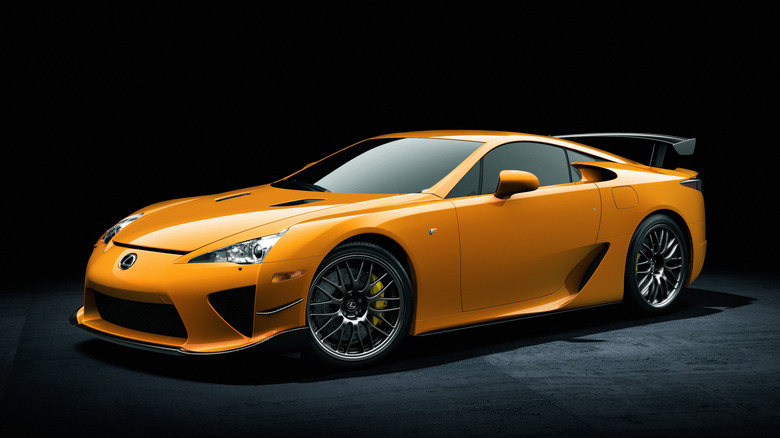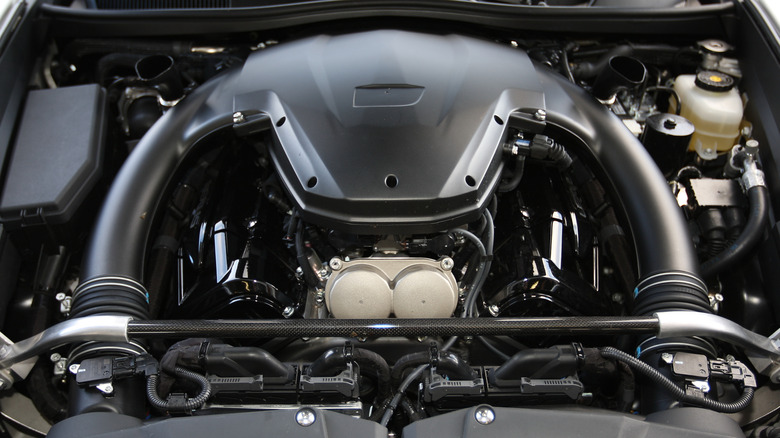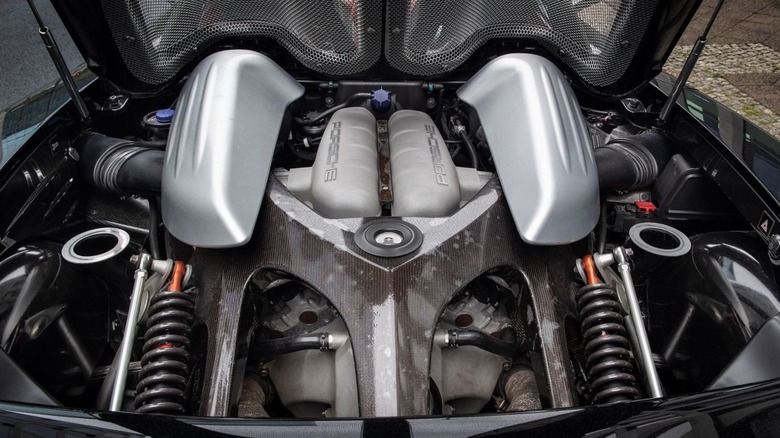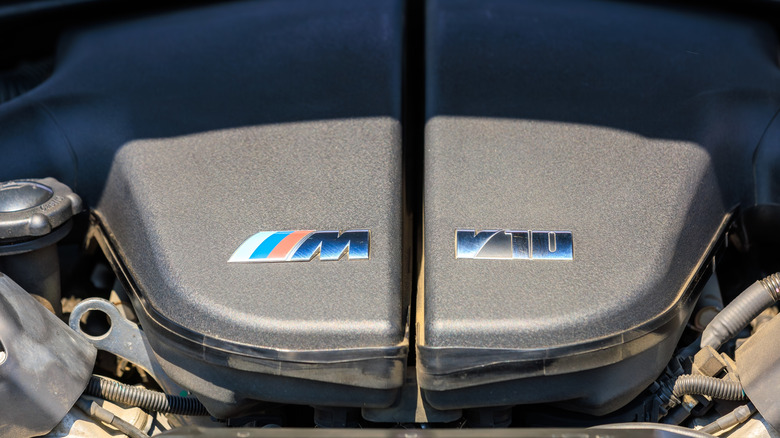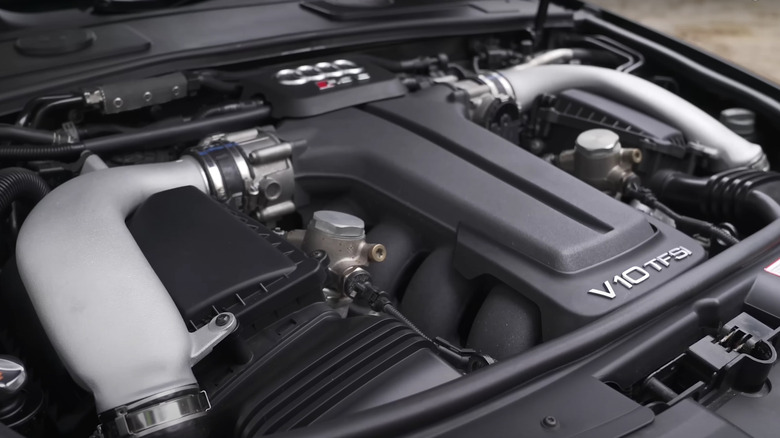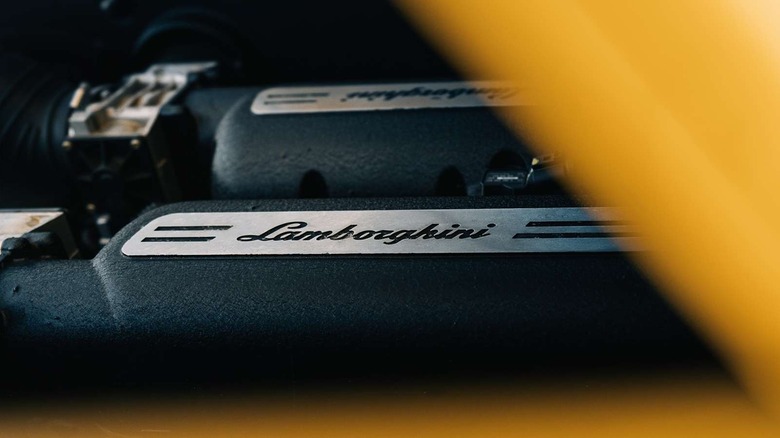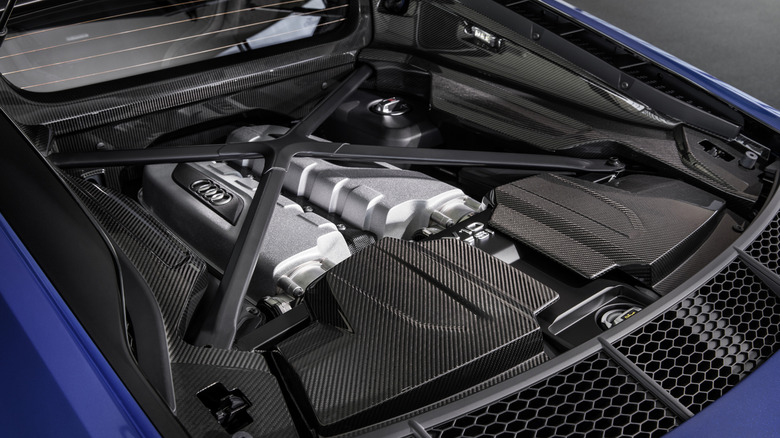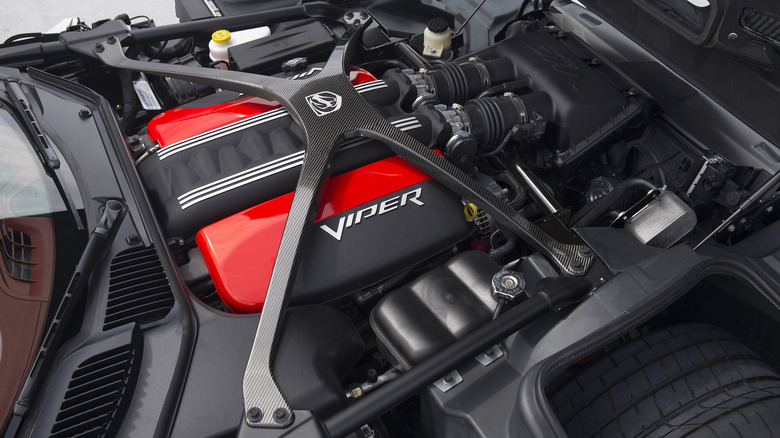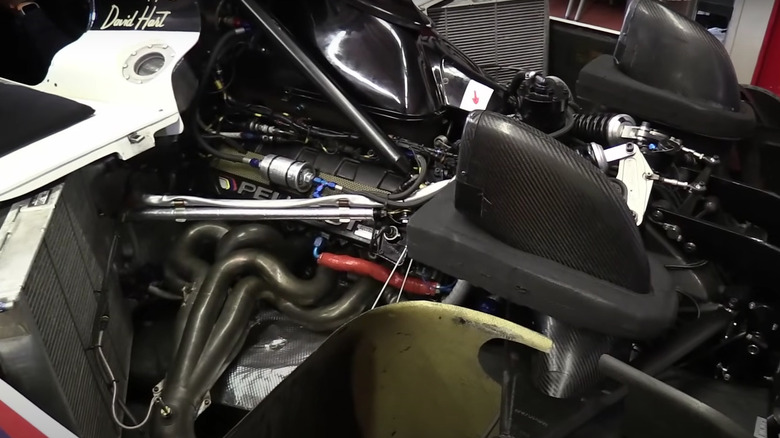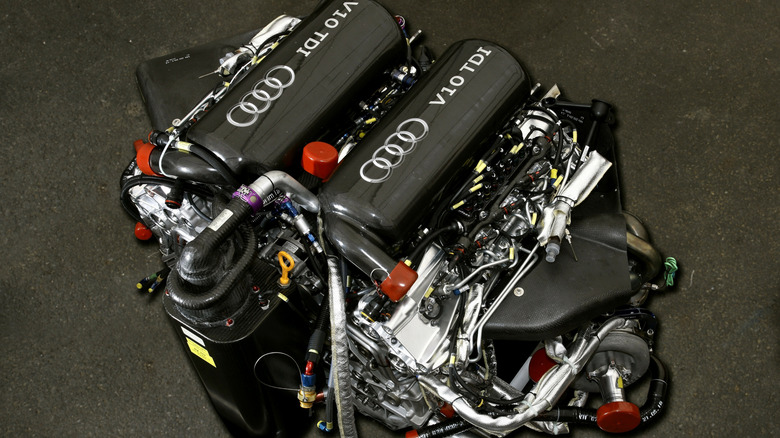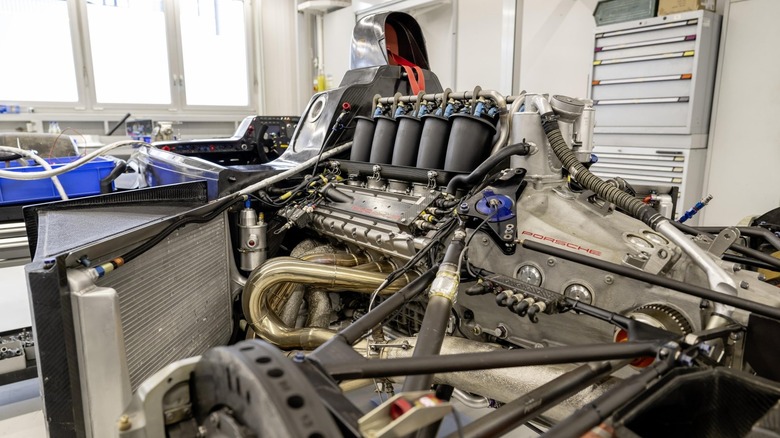12 Of The Best-Sounding V10 Engines Ever Made
The V10 engine has a special place in automotive history. It's one of the rarest configurations, often reserved for exotic supercars. In fact, until Formula One embraced V10 engines, the Viper was the only sports car to have one. Other V10s were only available in trucks. Still, at the turn of the millennium, many more auto brands followed suit and introduced V10s. Some were directly influenced by F1 teams, others just wanted to compete.
We are very happy this happened, because V10s are perhaps the most sonically pleasing engines ever made. Find any list of the best-sounding engines ever, and there will surely be a V10 somewhere. The screaming, V10-powered F1 cars are also regarded by many as the best sounding. Not a small feat, considering F1 also utilized V8s, V12s, and even V16s.
Okay, but what are the best-sounding V10 engines ever made? Well, we could list every engine from the F1 V10 era and call it a day. Still, we made it a bit more challenging and decided not to include them in this list. Instead, we'll focus mostly on road-legal V10s, but also V10s from other motorsport competitions. Let's dissect these amazing machines.
Lexus LFA 4.8L V10
Visceral, yet incredibly sophisticated, the naturally aspirated V10 inside the Lexus LFA is arguably the best-sounding engine ever made. It's a marriage of precision and power, reminiscent of Toyota's efforts in the F1 V10 era, offering a truly mesmerizing aural bonanza. Deep and throaty at idle, LFA's V10 sounds like an angry animal slowly waking up. As the revs climb, the sound intensifies significantly into a high-pitched, sharp metallic tone. Near the 9,000 rpm redline, you'll hear an F1-like sonorous crescendo that has no equal in the motoring world.
But LFA's V10 doesn't sound like that just by accident. Co-developed with Yamaha's acoustic experts, the 1LR-GUE V10 has a special surge tank with ribbed walls, inspired by Yamaha's musical instruments, to enhance the sound. Special acoustic ducts and a sound adjuster panel were also employed to channel the most desired frequencies into the cabin, particularly over 3,000 rpm. To say Lexus and Yamaha went berserk with the sound development would be an understatement. As a cherry on top, the LFA also has a titanium, valve-actuated, multi-stage muffler, which created that unique F1-like noise.
But the Lexus LFA engine isn't special only because of its sound. It's a technological tour de force, with every detail designed to perfection. The 4.8-liter unit has 10 individual throttle bodies, titanium alloy conrods, a lightened crankshaft, and 12-hole fuel injectors. It's also as small as a V8 and as light as a V6, and it made 553 hp at 8,700 rpm in the regular model, or 563 hp in the Nürburgring Edition.
Porsche Carrera GT 5.7L V10
Ready for another high-revving acoustic treat? This time, it comes from Porsche's only road-legal V10 machine, the Carrera GT. With an engine sound sometimes compared to the LFA's V10, Porsche's race-derived, 5.7-liter unit confirms that V10s are probably the best-sounding engines around.
Ferocious and spine-tingling, Carrera GT's special V10 has a similar sonic signature to the LFA. It starts with a low rumble at idle, but as you ramp up the revs, it starts screaming with an increasingly high-pitched noise. It's never tiring, though — it almost sounds like it's asking for more revs. Initially developed for F1 and Le Mans, it's not surprising that the Carrera GT sounds almost like an F1 car. Overall, though, it has a rougher tone than its Japanese counterpart. Less sophisticated, if you will. Still, some prefer Porsche's approach, and we can't argue with that.
Two things set the Carrera GT apart. It has a six-speed manual gearbox with a light ceramic clutch — a big plus for driving engagement. You can also remove the roof and enjoy the V10 in its full glory. It has no special sound chambers, but the Carrera GT never needed those.
Porsche's 5.7-liter V10 is also more powerful, producing 605 hp, enough for a claimed top speed of 205 mph. It has a slightly lower 8,400-rpm redline, but instant throttle response. Also, it's an engineering gem, with a light alloy crankcase and titanium connecting rods. Additionally, it is positioned in the center of a super-stiff and lightweight carbon fiber monocoque for improved weight distribution.
BMW M5 E60 & M6 E63 5.0L V10
Like Lexus' and Porsche's engines, BMW's V10 has its roots in the F1 V10 era. Unlike its rivals, though, the Bavarian automaker used its naturally aspirated gem to improve its already existing automobiles — the 5 Series and 6 Series. This made the M5 E60 and M6 E63 quite special, as they remain the only V10-powered cars with the BMW badge.
But don't let that fool you into thinking the S85 engine doesn't deserve its place in the pantheon of V10 greats. The 5.0-liter unit produced 500 hp at 7,750 rpm and had an 8,250-rpm redline. It had F1-derived tech, like individual throttle bodies, super-light parts made from eutectic aluminum and silicon alloy, and magnesium-steel conrods. Heck, BMW even used the same production methods as its F1 engine team.
All this tech, unfortunately, made the S85 quite complex and unreliable. It's notoriously expensive to maintain and repair as well. And let's not forget about the rough and sensitive single-clutch automated transmission, which was unfortunately paired with most S85-powered cars.
Rest assured — you'll quickly forget about all these issues once you hear the BMW V10 sing. Tactile and precise, with a raspy, metallic edge at higher rpm, the S85 gives the M5 E60 and M6 E63 an F1 soul. It's energetic, yet muscular. Raw, yet intricate. Crucially, it charges you with adrenaline like no other BMW M car ever.
Audi RS6 C6 5.0L Twin-Turbo V10
The M5 E60 was so headline-grabbing that it may have inspired Audi to launch a V10-powered family car of its own. So, 3 years later, Audi launched the V10-powered RS6 C6 in sedan and wagon form.
Audi's parent company, VW Group, also owned Lamborghini, so the Ingolstadt-based automaker just borrowed the 5.0-liter V10 from the Gallardo. In Lambo's mid-engine supercar, it produced 512 hp at 8,000 rpm — just the right amount to compete with the M5, right? Of course not. With the RS6 C6, Audi went the twin-turbo route to trump its biggest rival, and crucially, give its sizeable executive machines more torque in the low end. More precisely, 571 hp and 479 lb-ft of torque. In 2008, these numbers were mind-boggling. On a closed course, Audi pushed the RS6 to a scary 188 mph (303 km/h).
Turbocharged engines seldom sound as visceral or exciting as naturally aspirated ones. Turbochargers act as mufflers for the intake and exhaust, which kills some of the satisfying noises. Even so, Audi did a stellar job with the Lamborghini-derived V10. What it lacks in motorsport vibe, the V10 complements with a deeper, more muscular tone. It still has that unique V10 signature, sounding throaty and aggressive near redline. Let's not forget the oxygen-sucking rush from the turbochargers, which gives this engine a unique character.
Lamborghini Gallardo 5.0L V10
The baritone twin-turbo V10 suited the RS6 C6 quite well, but it doesn't gel with a mid-engine Lambo supercar. Gallardo's original 5.0-liter V10 was a naturally aspirated unit made to stir the soul. But it's not only the lack of turbos that sets this engine apart. Lambo's engineers went to great lengths to deliver a mesmerizing sonic extravaganza. Notably, the engine has an unusual 7-8-5-2-1-10-9-4-6-3 firing order, which gave it a far more raw, mechanical sound. The 90-degree angle between the cylinder banks is also unusual, adding to the signature noise.
But how does it really sound? It's raspy and throaty at lower revolutions, maybe even a bit, but in a good way. It's just the sort of noise that will awaken your senses before you even start accelerating. But of course, you'll have the most fun at higher rpm. Like any good V10, Gallardo's 5.0-liter reveals an angrier attitude as the revolutions build up. It retains the mechanical edge, but with even more fury. Near the 8,050-rpm redline, it turns into a higher-pitched noise, but without losing its raspy edge.
Lambo's V10 was also very potent for its era, producing 493 hp and 376 lb-ft of torque. Two six-speed transmission options were available — a manual and an automated manual. Both sprinted to 62 in 4.2 seconds, but it's the gated manual that steals the show.
Audi R8 & Lamborghini Huracán 5.2L FSI V10
Audi's 5.2-liter V10 succeeded the Lambo 5.0-liter in the Gallardo as a more modern unit with a higher power ceiling. In the Gallardo LP570-4 Superleggera, for instance, it produced 562 bhp. However, the engine's rise to prominence happened in the R8 and Huracán, both mid-engine supercars that shared the same platform.
Purists will tell you that Audi's engine isn't as raw as Lambo's, and they'd probably be right. But don't dismiss the 5.2-liter just yet, because it's one of the most well-engineered naturally aspirated engines around. Hardly surprising, as Audi Sport GmbH used technology it honed during its successful Le Mans program, like the Fuel Stratified Injection (FSI) and dry sump oiling systems.
But what about the sound? Well, an important piece of information is that Audi's 5.2-liter has a different 1-6-5-10-2-7-3-8-4-9 firing order. As a result, it's a bit more refined than its Lambo predecessor, without the characteristic raspy noise. Still, it builds up perhaps more nicely toward the 8,700-rpm redline, with more of a high-pitched, F1-like noise. Overall, the 5.2-liter produces an incredibly satisfying, rich, harmonic sound that gets under your skin.
In the rear-wheel-drive Lamborghini Huracán Tecnica, Audi's V10 produced 630 hp and 417 lb-ft of torque. Still, colleague Michael Teo Van Runkle thinks that the absurdly fun, off-road-ready Lamborghini Huracán Sterrato is the best fit for the V10, despite it making a reduced 610 hp. There is also a case to be made about the six-speed manual R8 V10, one of the last supercars with a stick shift.
Audi S8 D3 5.2L FSI V10
Want to enjoy a V10 soundscape, but dampen every other noise coming from a car? The Audi S8 D3 is the most luxurious car with a V10, designed to give you the quietest possible ride at speed, while tickling your ears with supercar-like engine noise. The naturally aspirated 5.2-liter V10 inside this super-sedan is related to the engine in the R8, Gallardo, and Huracán.
It's not the same engine, though. Because the S8 isn't designed to be driven on track, it has a wet sump oiling system. The crankshaft is also not as stiff, and the pistons are made from cast aluminum. As a result, it produces a lower horsepower rating of 444, but the same 398 lb-ft of torque as the Gallardo, delivered at just 3,000 rpm. That's enough for a 0-62 mph (0-100 km/h) sprint of 4.9 seconds, despite the ancient six-speed automatic and high curb weight (4,609 pounds).
Although not as ferocious as the version built in Audi's and Lambo's supercars, the 5.2-liter V10 does sound quite lovely in the S8. It has more of a baritone sound to it, which suits this car better. Push it harder, though, and you can hear the angry V10 growl everybody loves. It has that motorsport quality in it, as if a small racecar was buried deep beneath the S8's hood.
Dodge Viper VX ACR 8.4L V10
The Dodge Viper has always been the odd one out in the American auto industry. Instead of a V8, it was always equipped with a huge, monstrous V10. With a capacity of 8.4 liters, the last-ever Viper V10 trumps even heavy-duty trucks. Unsurprisingly, it makes a lot of power. In the hardcore Viper ACR, it produces 645 hp and bombastic 600 lb-ft of torque. No replacement for displacement, eh? Not when 0-60 takes only 3.3 seconds, provided you can keep the rear wheels from spinning. The best part — Viper ACR's V10 is paired to a six-speed manual.
Interestingly, the first-gen 8.0-liter Viper engine was based on the truck-focused Magnum V10, but redesigned in collaboration with Lamborghini. Thanks to that, Viper's engine always had an aluminum block but kept the unique pushrod design. As a result, Viper's engine has always had a distinctive tone to it, though it is at its best in the last-gen Viper VX ACR. Raspy, but with a lower frequency than other V10s. Irregular, even, particularly at lower revolutions. Still, it has that muscular tone you'd come to expect from an American sports car. Almost like a muscle car, but with a bit more complexity. Crucially, it suits the track credentials of the Dodge Viper ACR, which has racecar-like aero for crazy cornering speeds.
Judd Power GV 4.0L V10
Judd Power's 4.0-liter V10 engine appeared in many F1 cars, including Benettons, Tyrrells, and Arrows. Judd's engine was not part of the V10 era, when engines were limited to a 3.0-liter capacity. Besides, the GV V10 was initially designed to power LMP1 cars for the Daytona 24 Hours and 24 Hours of Le Mans. It was powerful, yes, but Judd Power also designed it with fuel efficiency and reliability in mind.
Unrestricted, the 4.0-liter unit produced up to 750 hp, with an 11,000-rpm rev limit and a low weight of 145 kg (320 pounds). Of course, it also has individual throttle bodies, which gave it an amazing sound signature. Like any good racecar engine, the Judd 4.0-liter V10 sounds irregular at idle, begging you to press the gas pedal. Even so, it's a characterful, thunderous noise.
As the revs climb, though, it turns into a more feral, energetic noise. Still, Judd's V10 also sounds sharp and precise at higher rpm. It's harmonic, even, producing all the right frequencies to give you some serious goosebumps. Predictably, it pops and crackles on downshifts, which gives it even more character. If only you could put it in a regular car, right? Well, it was already done — a Judd-powered V10 GR Supra appeared at Mobil1's booth at SEMA in 2021.
Peugeot 905 Evo 1 3.5L V10
Peugeot's win at the 1992 24 Hours of Le Mans is a historic one for the brand. It allowed the French automaker to showcase its engineering prowess, beating the lightning-fast Toyota TS010. The automaker repeated its success in 1993, taking all three places on the podium. The car that brought Peugeot glory was the 905 — one of the Group C beasts.
A big part of 905's success was the streamlined body, which gave it an excellent top speed on the Mulsanne straight. Yet, the star of the show was undoubtedly the 3.5-liter, naturally aspirated V10. It produced 650 hp at crazy-high 12,500 rpm, enough to bring the featherlight carbon-fiber 905's curb weight of around 1,750 pounds to a top speed of 217 mph.
Racing aside, we are here to talk about how glorious Peugeot's engine sounds. It's quite the angry machine, even at lower revolutions. Still, Peugeot's V10 is at its best at high rev, when the high-pitched howl takes over. It is a clearer, crisper sound than Judd's, as if there is a whole symphony of instruments hiding inside the 905's exhaust. Close your eyes for a second, and it will fool you into thinking you're at the F1 track.
Audi R15 TDI 5.5L V10
Audi is one of the most successful auto manufacturers at Le Mans, and it's mainly thanks to its TDI turbodiesel engines. The combination of excellent low-down torque and unparalleled fuel efficiency gave Audi the upper hand over its gas-powered rivals. The automaker's first diesel-powered prototype for Le Mans was the R10 TDI, packing a 5.5-liter twin-turbo V12 that produced 650 hp and massive 811 lb-ft of torque.
For the second-gen R15 diesel prototype, Audi went with a smaller, lighter, and more economical 5.5-liter, twin-turbo V10. The new engine produced over 600 hp and 770 lb-ft of torque, while being 100 mm (3.94 inches) shorter. Predictably, the turbodiesel V10 sounds unlike any gas V10 you've heard. There is no high-pitched noise. No screams. Still, the V10 TDI has a unique, menacing sound as it passes by. It's quieter than a gas engine, but still raspy and bassy. Almost like a silent killer, if you will. You could capture some of the V10 TDI magic in the Volkswagen Touareg, but the road-legal 5.0-liter engine sounds much tamer.
Porsche LMP 2000 5.5L V10
Unlike Peugeot's and Audi's prototypes, the Porsche LMP 2000 never competed at Le Mans. It only covered 48 miles during two days of testing, before the project was killed. Porsche cited budgetary reasons for the demise of the LMP900 Le Mans prototype project, which is sad, because it was prepping to be a motorsport titan. Powered by a naturally aspirated, 5.5-liter V10 with nearly 600 hp, advanced aerodynamics, and a low 1,985-pound curb weight, the LMP 2000 should've immediately fought for overall victory at Le Mans.
Instead, the LMP 2000 remained under closed doors for 25 years. In 2024, though, Porsche uncovered its fallen hero. Not only that, but the German automaker restored the racecar to its former glory. Crucially, it allowed us to hear the V10 sing on the racetrack once again. Derived from Porsche's 3.5-liter Formula 1 concept engine, which also never raced, the 5.5-liter sounds almost like an F1 car. It's a complex, harmonious noise, combining a high-pitched scream with a low, satisfying rumble.
The LMP 2000 might've never been on the starting grid, but its legacy lived on in the Porsche Carrera GT. The V10 stunner in Porsche's supercar, which we already mentioned on this list, was directly based on the LMP 2000's engine.
